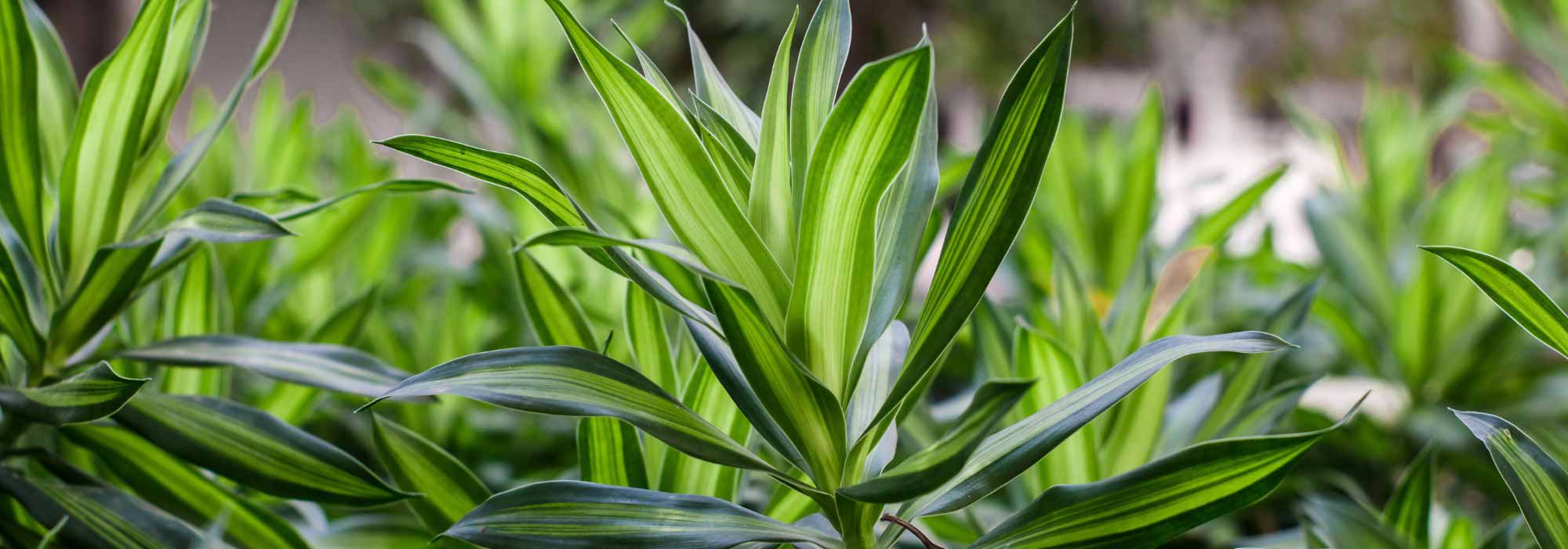
Dracaena (Dragon tree): planting, cultivation, and care
Contents
Dracaena in a nutshell
- This tropical plant from Africa and Asia is ideal for indoor cultivation in our latitudes
- Its slender and graphic foliage adds an exotic and modern touch
- Easy to care for, it requires minimal maintenance
- Thanks to its air-purifying properties, it helps to clean indoor air
- Versatile, it easily fits into minimalist, bohemian, or natural decor
the word from our expert
The Dracaena or Dragon Tree is a popular houseplant prized for its graphic and exotic, often variegated foliage. Native to tropical regions of Africa and Asia, it thrives perfectly in pots in our homes, where it enjoys a warm and protected environment. Placed away from direct sunlight, it retains all its brilliance and easily adapts to different atmospheres in the house. The most commonly cultivated varieties are Dracaena fragrans and the Dracaena marginata, the two most popular varieties.
Easy to care for, the Dracaena requires minimal maintenance and is rarely prone to diseases: moderate watering, allowing the soil to dry out between waterings, and a stable temperature between 18 and 25°C are sufficient for its well-being. Undemanding, it forgives missed waterings and is ideal for those who want a green interior without hassle.
In addition to its aesthetic appeal, the Dracaena is recognised for its air-purifying properties. It helps to clean the air by absorbing harmful substances such as formaldehyde, benzene, or xylene, which are frequently present in our homes. This is an added bonus for creating a healthy and pleasant environment.
Discover this tropical houseplant, perfect for adding a touch of freshness to a bright living room, apartment, or office, and creating a soothing green atmosphere!
Botany and description
Botanical data
- Latin name Dracaena
- Family Asparagaceae
- Common name Dragon tree
- Flowering Rare indoors
- Height Between 30 cm and 1 m
- Exposure Bright
- Soil type Light, well-draining and airy substrate
- Hardiness Frost-sensitive
The Dracaena belongs to the Asparagaceae family, although it was long classified among the Agavaceae. Its name comes from the Greek drakaina, meaning “female dragon”, in reference to the reddish resin that some species produce. Once called “dragon’s blood”, this substance was used in traditional medicine and as a natural dye. The Dracaena is best known by the common name “dragon tree”.
In its natural habitat, it is found mainly in tropical Africa, Madagascar, and Southeast Asia, growing in humid forests or semi-arid zones, depending on the species. The Dracaena is a robust, slow-growing plant that can live for several decades indoors, gradually forming a thick and elegant trunk.
Among the most commonly cultivated species are the Dracaena marginata, recognisable by its long, slender leaves edged with red, and the Dracaena fragrans, also known as the “Madagascar dragon tree”, whose flowers emit a pleasant fragrance and whose broad green or variegated leaves resemble those of corn. The Dracaena compacta, more compact, stands out for its dense and structured foliage, while the Dracaena surculosa, more unusual, features spotted leaves that give it a unique appearance. Some arborescent species, such as the Dracaena draco, emblematic of the Canary Islands, can reach up to 12 metres in height in their native habitat.
The Dracaena is distinguished by its slender and graphic habit, upright with a silhouette that gives it the appearance of a small palm tree. Its root system is shallow but dense, allowing it to anchor well in pots. The trunk, sometimes multiple, is generally thin and woody, marked by the scars left by fallen leaves. Some species develop branching, but most retain a vertical form with foliage in a tuft at the top. Some species, like the Dracaena compacta, do not exceed 50 to 80 cm in height, making them perfect for small spaces. Conversely, the Dracaena fragrans or the Dracaena marginata can reach 2 to 3 metres indoors, adding a beautiful verticality to large rooms.
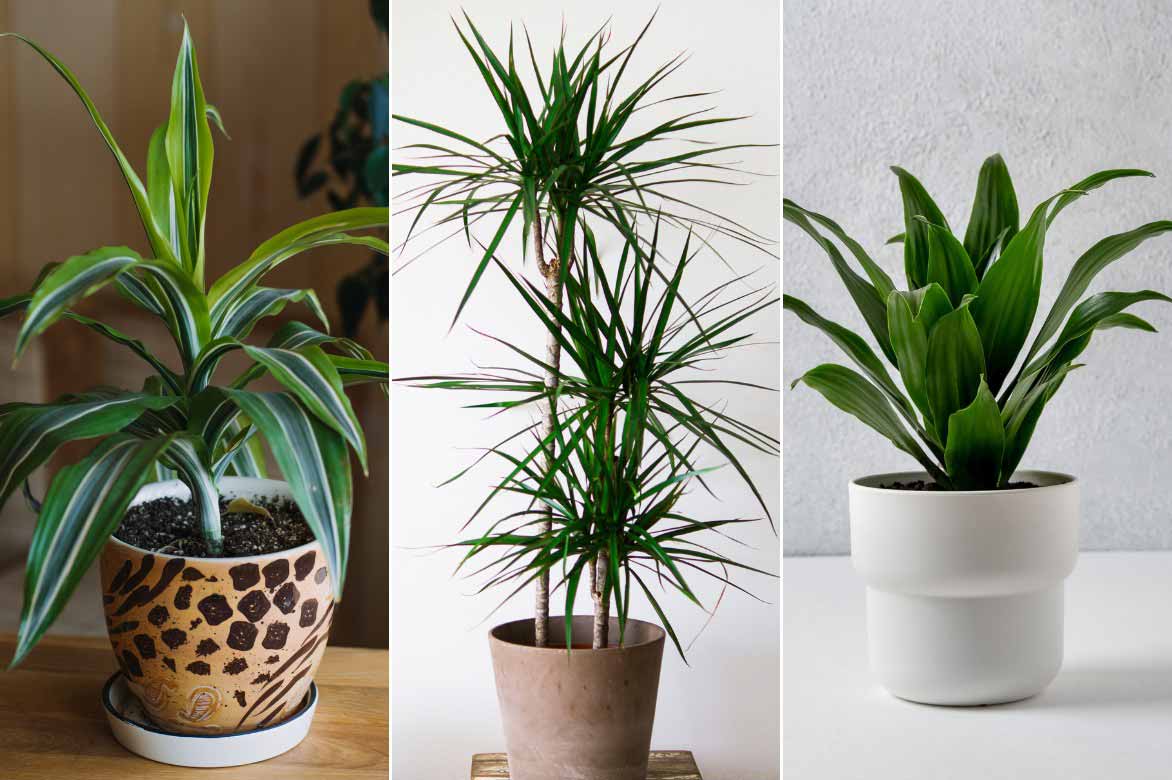
Dracaena fragrans, Dracaena marginata and Dracaena compacta
The foliage of the Dracaena is characterised by evergreen leaves, elongated and arranged in a rosette around erect or branched stems. They generally measure between 30 and 90 cm in length and 2 to 10 cm in width, depending on the species and growing conditions. Their shape is most often linear to lanceolate, with a tapered apex and smooth edges, sometimes slightly undulate. The texture of the lamina is flexible to leathery, with a surface that can be glossy or matte, depending on the variety and light exposure. The foliage is often arched or trailing, giving the plant an elegant and light silhouette.
The colour of the leaves ranges from deep green to light green, with possible shades of yellow, cream, or red, usually in the form of longitudinal striations or coloured edges. The veins are parallel, subtle but visible. The petiole is short or absent, with the leaves directly attached to the stem, forming a dense crown at the top of the trunks. Over time, the lower leaves dry out and fall naturally, revealing smooth and ringed stems, characteristic of the Dracaena genus.
Flowering indoors is rare, but when it occurs, it manifests as small clusters of flowers, often white and slightly fragrant. In the wild, these flowers can give rise to small coloured berries, but indoors, fruiting is exceptionally observed.
The Dracaena is one of the air-purifying plants recognised by NASA, capable of absorbing toxins such as formaldehyde, benzene, and trichloroethylene present in indoor air.
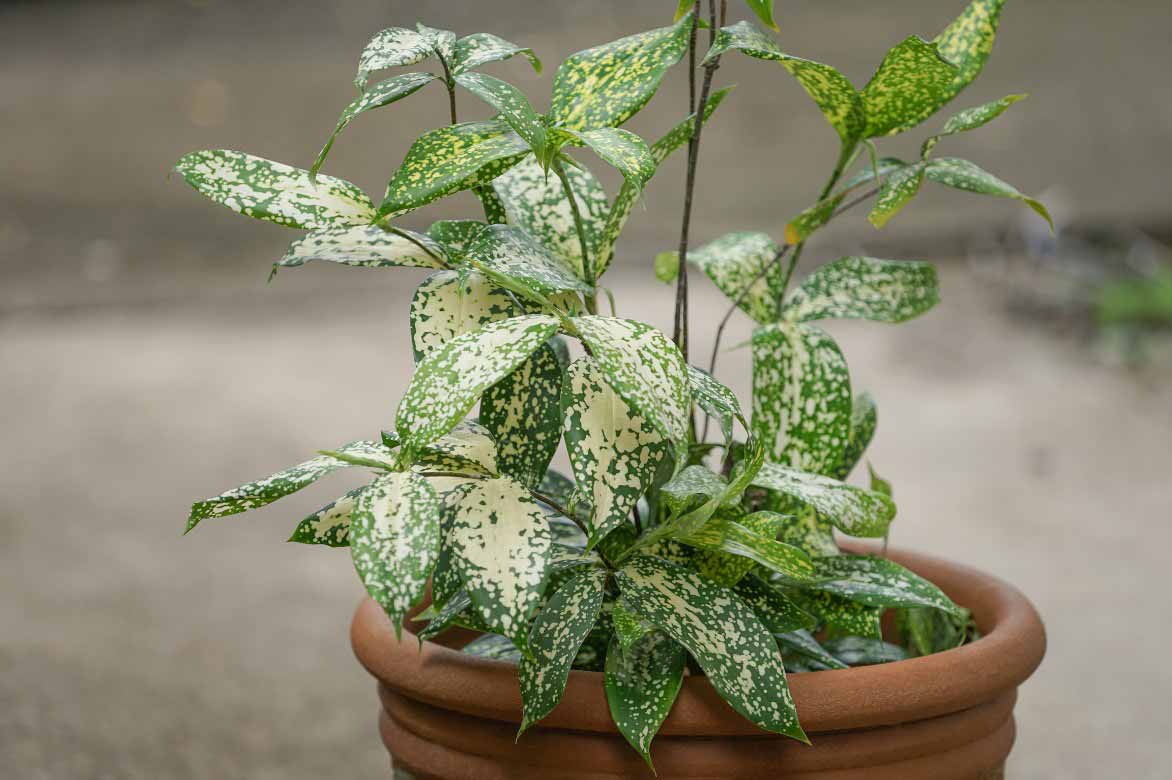
The Dracaena surculosa offers very original variegated foliage
Main species and varieties
Planting the Dragon Tree
Where to place a dracaena?
The Dracaena is a frost-sensitive plant by nature, unable to withstand cold temperatures and frost. It thrives best in a warm environment, with a minimum temperature of 15°C, which is why it is mainly grown indoors in our latitudes. This tropical plant must be protected from cold drafts and sudden temperature changes. Place your dragon tree in a bright spot, but sheltered from direct sunlight, which can scorch its leaves. It will appreciate indirect exposure near an east or west-facing window.
The Dracaena enjoys a moderately humid atmosphere, similar to the tropical forests it originates from. A stable temperature between 18 and 25°C will suit it perfectly, with relatively high ambient humidity to prevent its leaves from drying out at the edges.
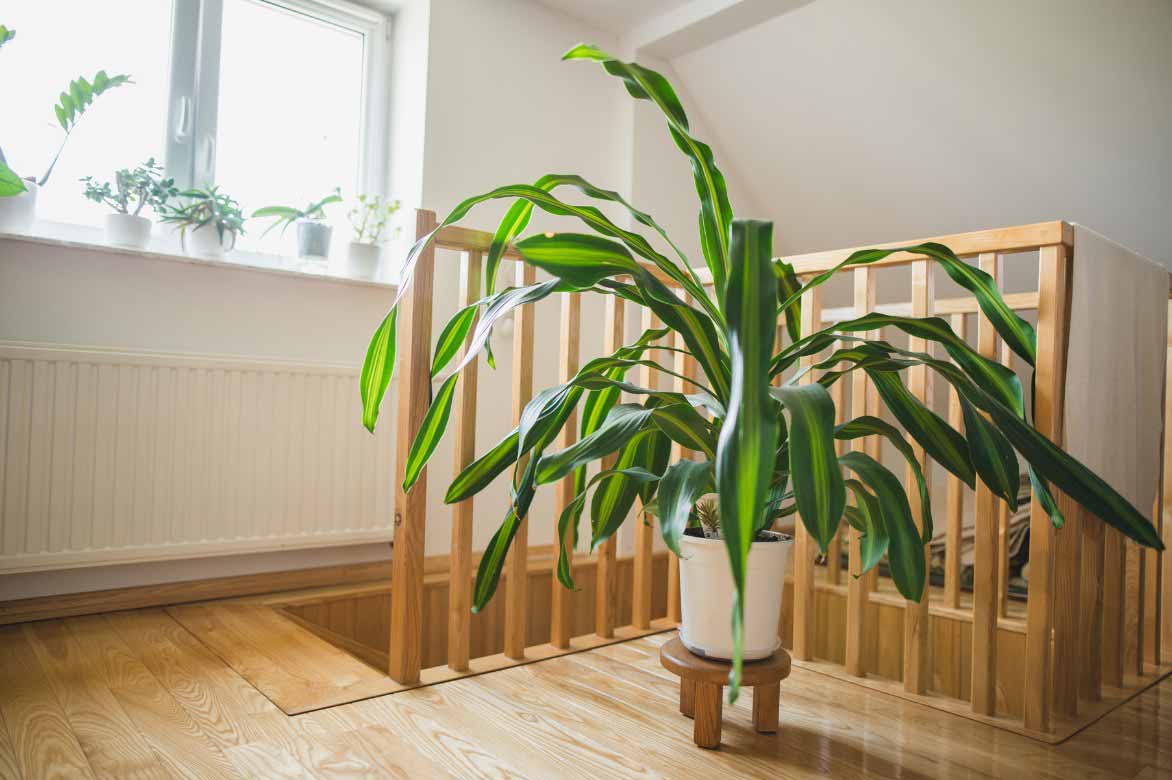
Place the Dracaena in a bright spot but sheltered from direct sunlight.
When to plant it indoors?
The Dracaena can be planted indoors all year round, as it is protected from climatic variations. Spring, however, remains the ideal time for repotting or planting, as the plant benefits from the resumption of its growth to adapt better to its new environment.
How to plant a Dragon Tree in a pot?
The pot must have drainage holes to prevent waterlogging. In terms of size, choose a pot slightly larger than the root ball, with a 2 to 3 cm margin to encourage root growth, as the Dracaena prefers being slightly snug.
To ensure its healthy development, the substrate should be light, well-draining, and rich in organic matter. Ideally, plant it in a mix consisting of 70% houseplant compost and 30% coarse sand or perlite.
- Place a layer of drainage (clay pebbles or gravel) at the bottom of the pot.
- Fill with the compost and perlite mixture.
- Place the Dracaena root ball, ensuring not to bury the collar.
- Top up with substrate and lightly firm it down.
- Water moderately and place the plant in a bright spot, away from direct sunlight.
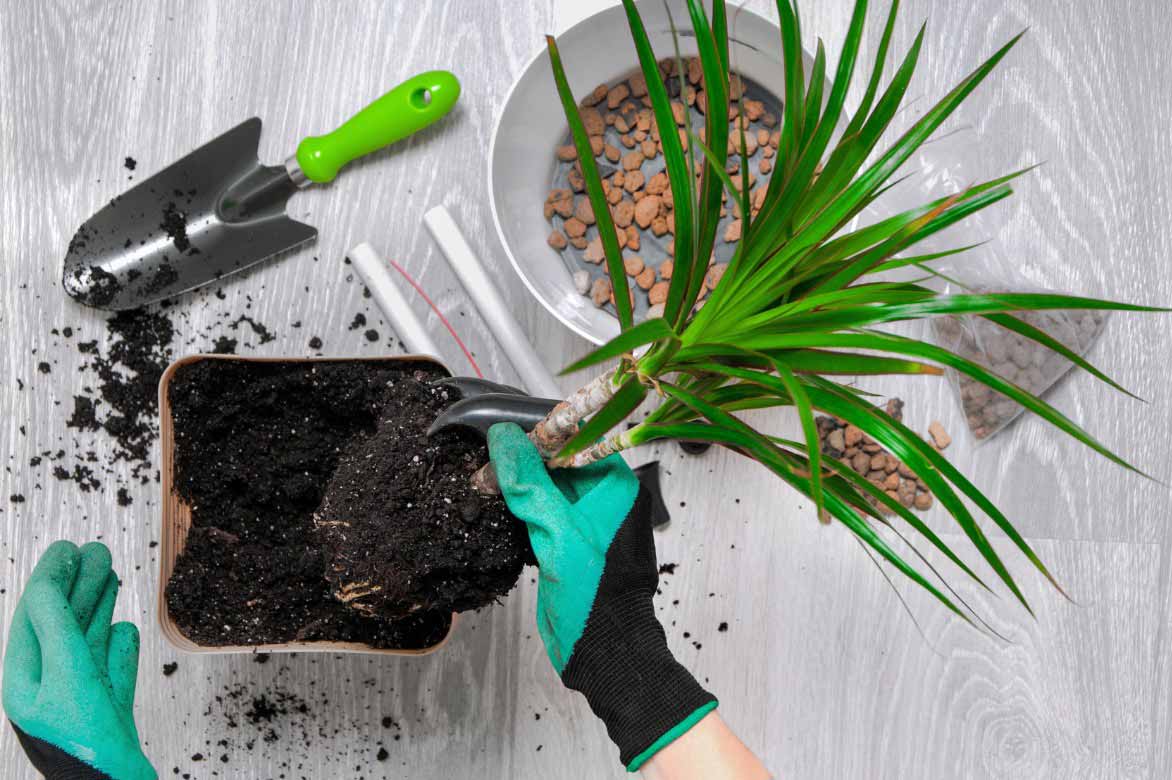
Plant the Dracaena in a pot slightly larger than the size of the root ball.
How to care for an indoor dracaena?
The Dracaena is a robust and low-maintenance plant, ideal for indoor spaces. With controlled watering, appropriate fertilisation, and a few simple precautions, it can thrive for many years while maintaining lush foliage.
When to water the Dracaena?
Watering the Dracaena should be moderate, as it dislikes excess water, which could cause the roots to rot. During the growth period, from spring to autumn, watering every 7 to 10 days is generally sufficient. Wait until the top layer of the substrate dries out before watering again. In winter, as the plant’s growth slows, watering should be even more spaced out, every two to three weeks, depending on the ambient temperature and humidity. Use non-calcareous water at room temperature to prevent leaf yellowing.
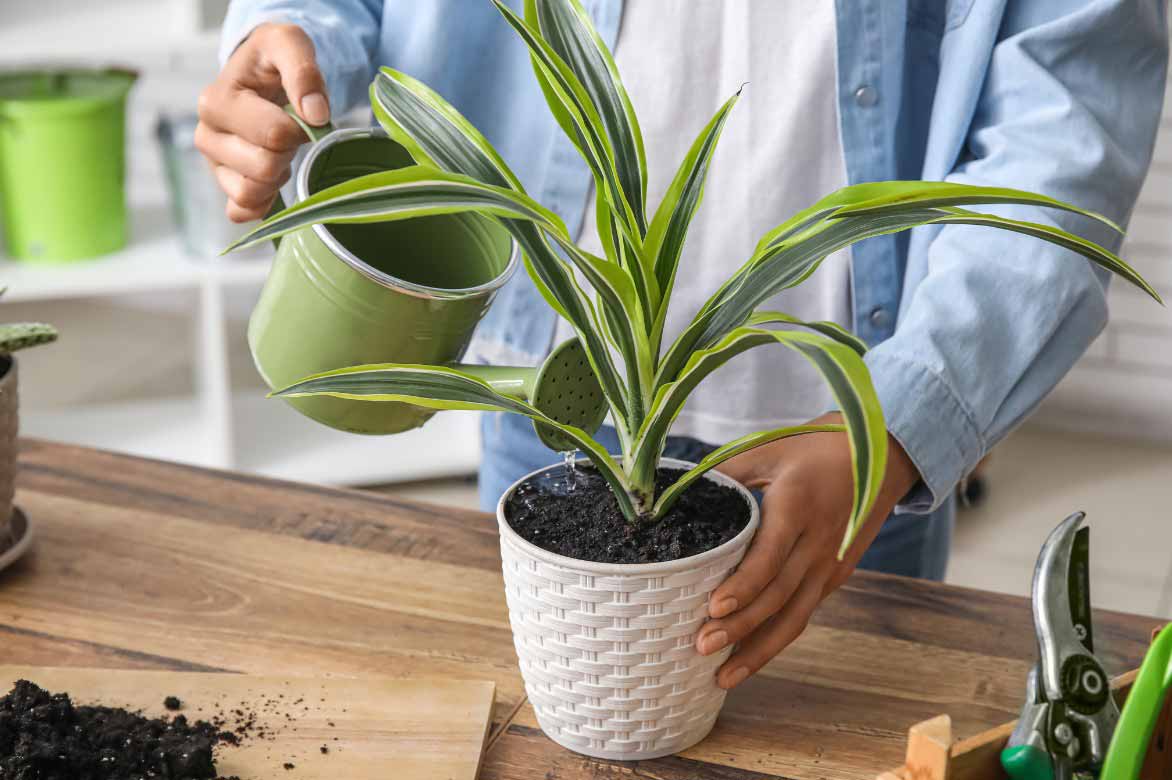
Remember to water your Dracaena regularly
Fertilisation: which fertiliser and how often?
To maintain dense and healthy foliage, the Dracaena benefits from fertiliser during the growing season. A liquid fertiliser for green plants, rich in nitrogen, can be added to the watering every three to four weeks from spring to late summer. In autumn and winter, fertilisation is unnecessary as the plant enters a dormant period.
Pruning and foliage maintenance
The Dracaena does not require regular pruning, but occasional pruning can help control its growth and improve its appearance. Over time, some varieties like the Dracaena marginata or the Dracaena fragrans can grow very tall and lose their leaves on the lower part of the trunk, giving them a bare look.
To rejuvenate the plant or encourage branching, you can cut the main stem in spring or early summer. The cut should be made with clean, sharp pruning shears at the desired spot, ideally just above a node. New shoots will appear within a few weeks from the base of the cut, giving the plant a bushier habit. Yellowed or damaged leaves should be removed as they appear to prevent the plant from wasting energy. They can be removed by hand or with clean scissors.
After pruning, it is important to maintain optimal conditions to encourage regrowth: good light, mild temperatures, and controlled watering.
Good to know: The cut stem can be propagated in a glass of water or directly in soil to grow a new plant.
Repotting the Dracaena
Repotting is necessary every two to three years, when the roots start to outgrow the pot or the substrate becomes depleted. It should be done in spring, choosing a pot slightly larger than the previous one. Between repottings, a simple top-dressing (replacing the top layer of compost) can suffice to provide fresh nutrients to the plant.
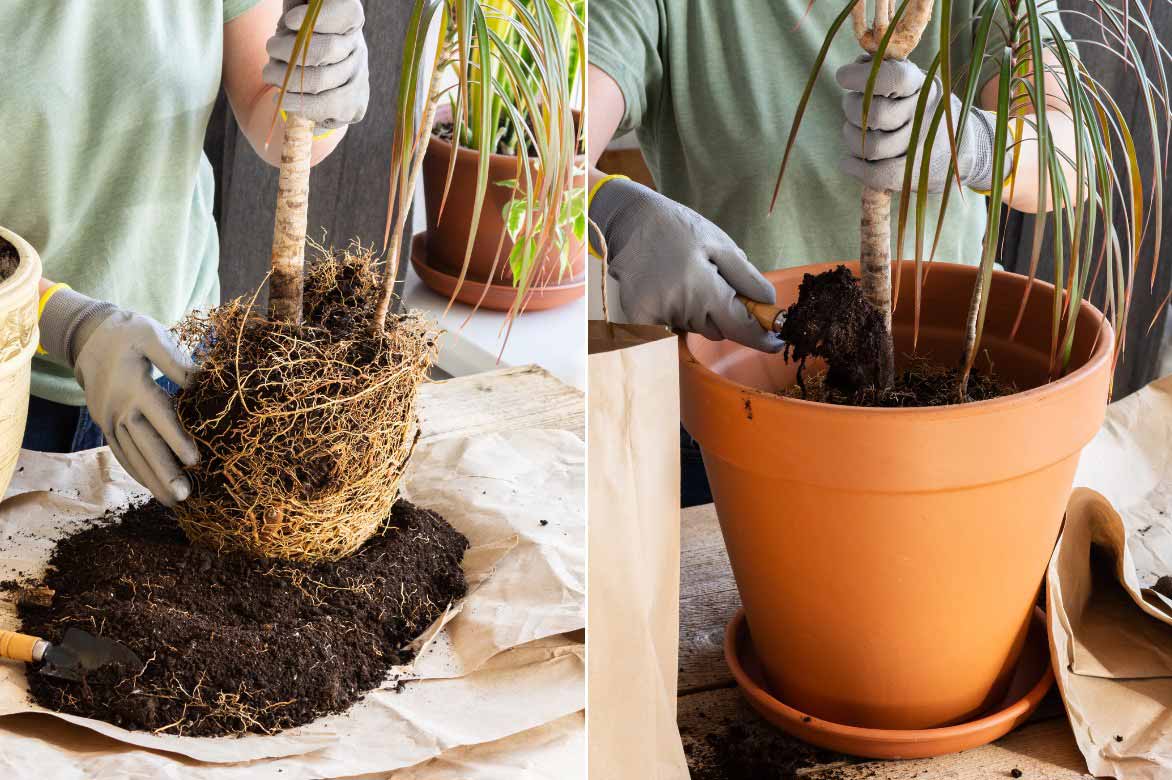
Repot your Dracaena every two to three years
What are the diseases and parasitic pests affecting Dracaena?
The Dracaena is a hardy plant, but it can be susceptible to a few parasitic pests and diseases, especially when growing conditions are not ideal. Regular monitoring allows for quick intervention in case of problems.
The most common parasitic pests
- Scale insects: These small parasitic pests, shaped like white cottony balls or small brownish shields, attach themselves to the stems and under the leaves, sucking the sap and weakening the plant. They can be removed by gently rubbing them with a cotton pad soaked in 70% alcohol or by spraying a diluted black soap solution.
- Red spider mites: These tiny mites appear mainly in dry conditions, causing yellowing of the leaves and the formation of fine webs. An effective preventive measure is to regularly mist the foliage with water and increase ambient humidity. In case of infestation, treatment with black soap or nettle liquid fertiliser can be effective.
- Aphids: Although rare on Dracaena, these small green or black insects can sometimes colonise young shoots. A simple rinse under water or treatment with black soap will quickly eliminate them.
Common diseases and symptoms
- Root rot: This is caused by overwatering or insufficient drainage, leading to softening of the roots and general yellowing of the leaves. If the plant appears weak and the soil remains constantly wet, it is necessary to repot quickly into dry compost, cutting away affected roots.
- Yellowing leaves: A common sign that can be due to overwatering, lack of light, temperature shock, or depleted soil. If the base of the trunk becomes soft, it is often a sign of advanced rot.
- Brown leaf tips: In an overly dry environment, especially in winter with heating, Dracaena leaves may develop brownish tips. To remedy this, simply humidify the air around the plant by misting with soft water and use non-calcareous water for watering (filtered water or rainwater).
How to take a cutting from a Dracaena?
Propagation by cuttings of Dracaena in water is a simple and effective method to obtain a new plant.
- Choose a healthy shoot, at least 10 to 15 cm long, with several leaves. Cut the shoot just below a node (the place where the leaves grow), as this is where the roots will form.
- Remove the lower leaves to prevent them from soaking in the water, which could encourage rot. Keep only a few leaves at the top.
- Fill a glass or transparent vase with water at room temperature.
- Submerge the shoot in the water, ensuring that at least one node is immersed but without the leaves touching the water.
- Change the water every 4 to 5 days to avoid stagnation and the development of bacteria. Always use non-calcareous water to prevent stains on the leaves.
- Rooting may take 3 to 6 weeks, depending on the ambient temperature and humidity. When the roots are at least 5 cm long, the cutting is ready to be planted in soil.
- Once the roots are well developed, prepare a pot with a well-draining mix (houseplant compost and perlite). Plant the cutting, lightly firm the soil, and water to help establish the roots in the soil.
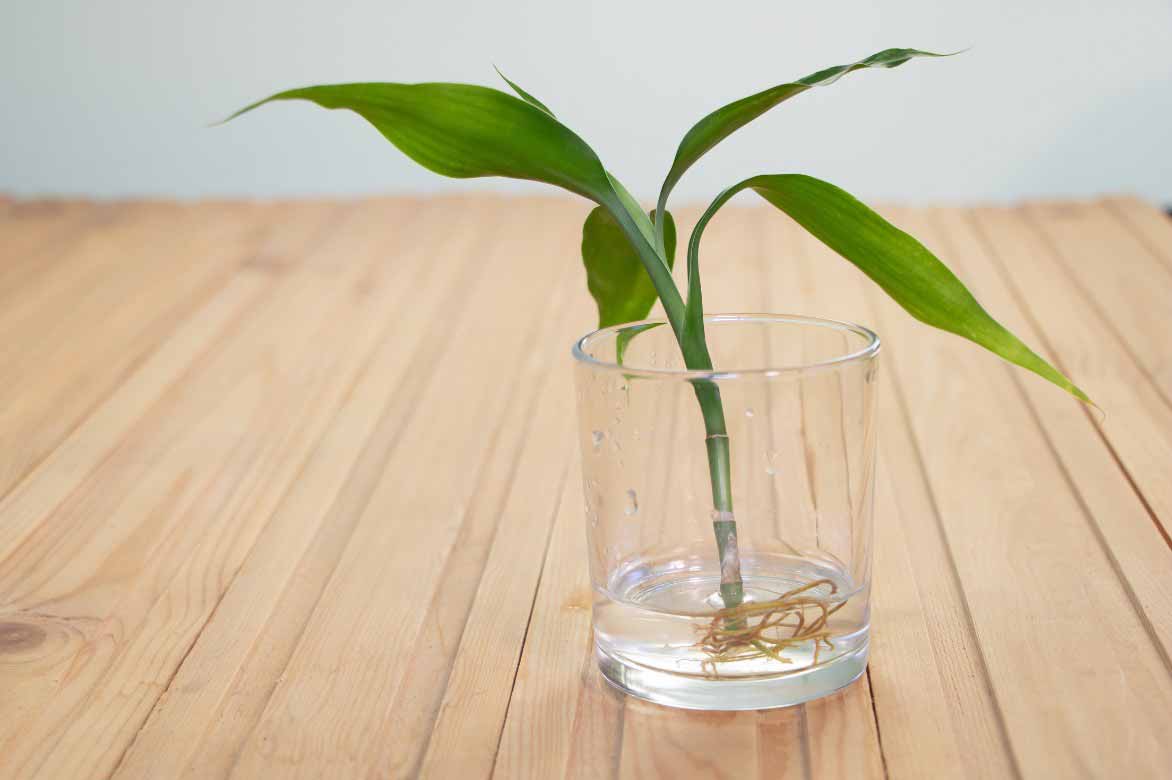
You can propagate Dracaena in water
Decoration Tips: How to Highlight a Dracaena?
The Dracaena is a tropical plant that can truly become a centrepiece in your home, seamlessly fitting into many styles thanks to its slender silhouette and graphic foliage. It adds a touch of greenery without overwhelming the decor. Varieties like Dracaena marginata or Dracaena fragrans are ideal for dressing up a workspace, a contemporary living room, or a bright entrance.
Which pot to choose for a Dracaena?
The pot plays a key role in showcasing the Dracaena. It should be both aesthetic and suited to the ambiance of your home. Here are some inspirations:
- For a modern and minimalist style: A smooth ceramic pot with clean lines and neutral tones (white, black, grey, beige) will highlight its elegance without cluttering the space. A cylindrical or slightly conical model is particularly suitable.
- For a natural ambiance: Natural materials like raw terracotta, paired with soft or pastel colours, will create a soothing and harmonious atmosphere. A textured stoneware pot can also enhance this natural vibe.
- For a bohemian ambiance: A wicker or rattan planter will elevate the exotic side of the Dracaena. Baskets made from natural fibres are also an interesting option to add a warm and authentic touch.
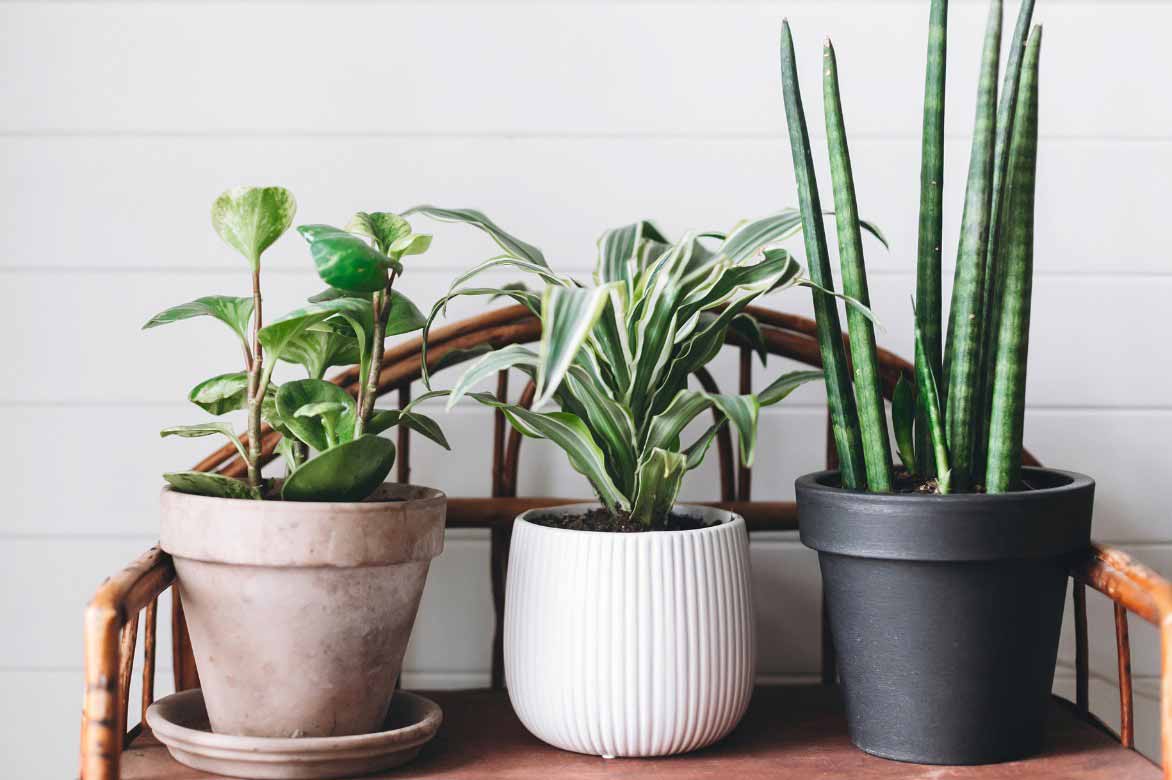
Peperomia, Dracaena and Sanseveria cylindrica
How to showcase it?
- Place the Dracaena in a bright spot, near a window, without direct sunlight.
- Play with height: a tall Dracaena will stand out when placed on the floor in an elegant planter, while a smaller model will find its place on a stool, shelf, or wooden stand.
- Create a jungle corner by pairing it with plants featuring contrasting foliage, such as a fern, pothos, or calathea. For a lush effect, combine it with trailing plants like ivy or varieties with broad leaves like the Monstera.
- Choose a stylish planter: in wicker or colourful ceramic, it will add the finishing touch to highlight its natural elegance.
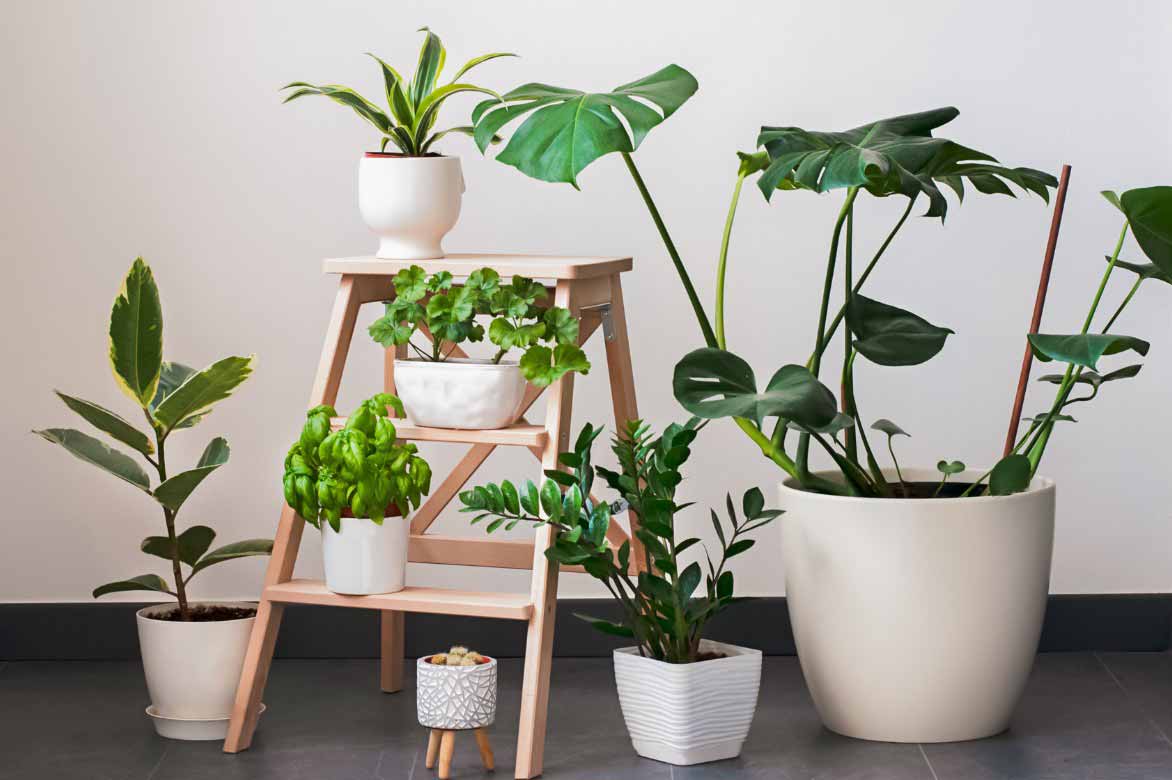
Create a jungle vibe by pairing the Dracaena with other indoor plants like Monstera, Ficus elastica, or Zamioculcas
Also see
→ Discover our wide range of houseplants.
Frequently asked questions
-
Why are the leaves of my dracaena turning yellow and falling off?
The leaves of a dracaena turn yellow and fall off for several reasons. Watering is often the cause. Excess water can cause the roots to rot, which prevents the plant from absorbing nutrients properly. Conversely, a lack of water leads to water stress and the drying out of the leaves. It is important to water when the soil is dry on the surface and to ensure the pot has good drainage.
Light also plays a role. Too much direct sunlight can scorch the leaves, while insufficient light slows growth and weakens the plant. It is best to place the dracaena in a bright spot without direct sunlight.
Temperature fluctuations and drafts can also cause leaf drop. A stable temperature of around 18 to 24 degrees is ideal.
The accumulation of mineral salts due to hard water or excessive fertiliser can also be a factor in the yellowing of the foliage. Occasionally rinsing the potting soil with soft water helps avoid this problem.
- Subscribe!
- Contents
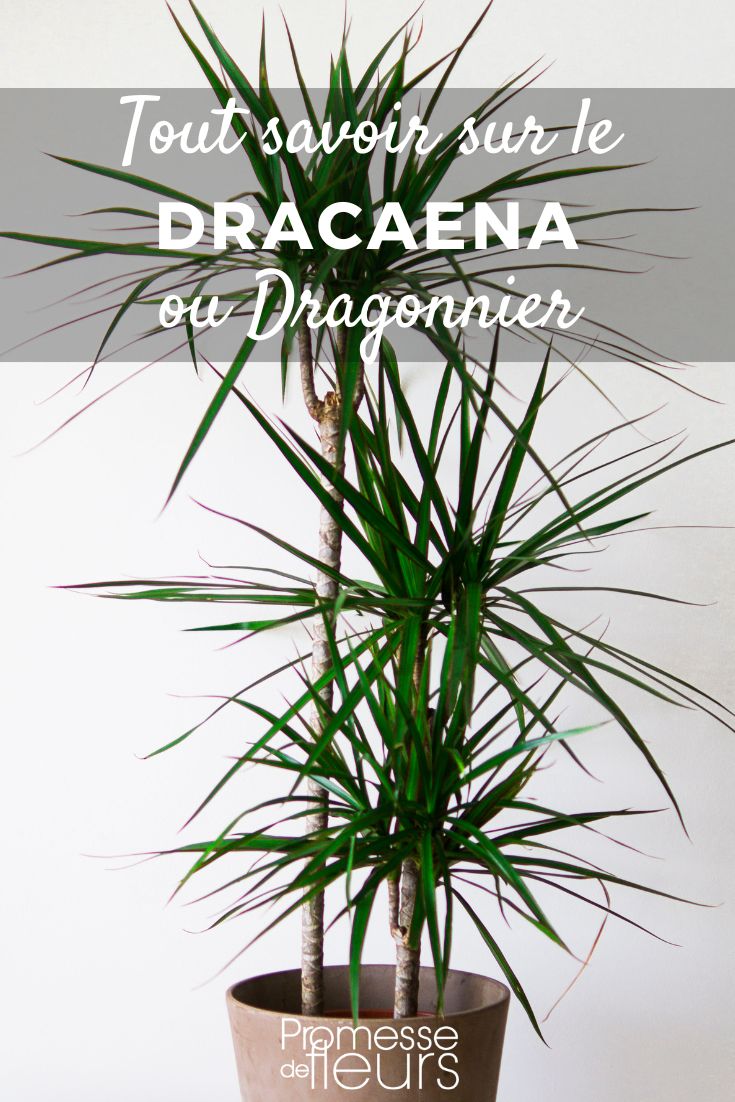































Comments